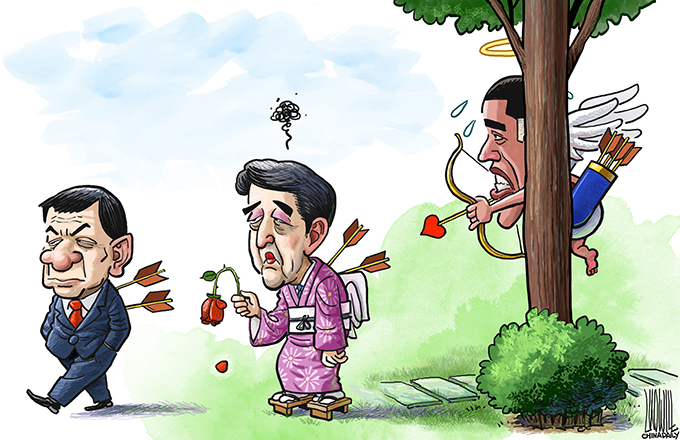ADB official: Q3 data show economy on track
 |
|
Customers look at iPhones in an outlet of Apple Inc in Hangzhou, capital of Zhejiang province. [Photo by Xu Kangping/For China Daily] |
Editor’s note: In a long-ranging interview with China Daily website, Jurgen Conrad, head of economics unit at the Asian Development Bank in China, comments on China's Q3 data and discusses the opportunities and challenges both China and world are faced up with in 2017. He highlights that Q3 data releases have confirmed that the structural transformation of the PRC economy remains on track.
1, what’s your evaluation of Q3 data? Many analysts pay special attention to PPI, the producer price index, which gauges factory-gate prices, rose by 0.1 percent year-on-year in September and had been falling in China since March 2012, does the PPI growth hint reform measures are taking effect?
Q3 data releases have confirmed that the structural transformation of the PRC economy remains on track. Growth is mainly driven by consumption and services. However, stabilizing growth at 6.7% year on year required substantial monetary and fiscal support, which boosted housing and infrastructure investment, and related industries. Producer price deflation decelerated further from 2.9% in Q2 to 0.8% in Q3. In September, annual producer prices inflation turned positive for the first time since early 2012. This can be mainly explained by stable or even rising global commodity prices, as the composition oft PRC's PPI is heavily geared towards commodities. However, global commodity price developments also depend on supply and demand from the PRC, among others, and strong infrastructure and real estate investment played a stabilizing role in this regard by strengthening demand for commodities. Cutting production capacity in the coal industry also likely played a role by reducing potential supply.
2, Could you give some predictions around the growth rate of China’s GDP for 2016 the whole year, and your outlook for 2017? Is it possible that China’s economy would reach the bottom at the end of 2016 and then welcome a rebound in 2017?
In light of PRC's growth performance in the first 10 months, we expect GDP growth in 2016 to be at 6.6% or even 6.7%, down from 6.9% in 2015. For 2017, we expect a continued slight moderation of growth, despite continued fiscal and monetary support, as the revival of the housing sector has almost run its course and it is increasingly difficult to further accelerate infrastructure investment growth. The deceleration of growth that has been unfolding over recent years is mainly driven by structural factors such as the declining workforce, wage increases, and high income levels, although cyclical elements exist. We therefore generally do not expect a rebound of growth. The growth pattern will rather be L-shaped. Whether the floor for the horizontal line of the L will be at 6.5% or lower mainly depends on the success of structural reforms that are required to increase the productivity of the economy.
3, Could you give some comments on the most impressive achievements and the bottlenecks that developed economies and emerging markets met in 2016 respectively?
Growth in emerging markets worldwide kept up well despite a difficult international environment, and in particularly anemic growth of world trade, weak demand from developed economies, the anticipation of US interest rate hikes that would have triggered capital outflows from emerging markets, increased instability in the Middle-East, and surprises like the Brexit referendum. The stabilization of commodity prices played an important role here, since many emerging markets depend on commodity exports. Policy challenges remain, including high credit growth in many emerging markets that is increasing financial vulnerabilities.
4, The world’s largest bond funds PIMCO launches a report on world economy outlook 2017 to claim that the dominant factors of world economy would change from 3C ( China, Commodities, Central Banks) to 3P (Productivity, Monetary/Fiscal Policy and Politics), how would you view the change they claimed?
This is a catchy slogan but quite possibly not much more than that. I am sure that China, commodities, and central bank policies will remain very important in 2017. Fiscal policies will certainly gain in importance, as we have seen already in 2016, because there are limits for what monetary policies can achieve. Politics will matter in 2017 as they did in 2016. Structural reforms that increase productivity should be a dominant factor and we will see whether they gain importance in 2017.
5, The World Economic Outlook 2016 issued by IMF calls for countries all over the world to use coordinated cooperation and effective policy levers to boost the growth prospect, what’s your views to use these two tools properly?
This is broad consensus among G20 countries and also fully supported by ADB.
6, People are paying intensively close attention on whether property market could sustain stable development and whether private investment would grow. How would you see these two areas in 2017?
For the PRC economy to increase its productivity, private investment is essential. However, the new drivers of growth in the service sector and consumer oriented industries are mostly less capital intensive than the old growth drivers of infrastructure investment, real estate investment, and heavy industry. So, even with an improved business climate, overall investment will growth at a rate that is lower as GDP growth in 2017 and actually over the coming years and decades, and the share of investment in GDP will fall. This is unavoidable. What policy makers need to achieve is that the share of private investment in overall investment increases again. 2016 was a setback in this respect. Demand for housing is fundamentally sound as migrants want to settle in cities and the urban middle class is looking for improved housing. However, while housing sales increased strongly in 2016 due to easily available mortgage lending, housing investment also increased and inventory levels remained high. This (the inventory level)?can only change if sales remain high in 2017 but investment stays behind. This would make the property market more stable. However, it would dampen growth as it is housing construction that adds value and not sales.
7, The research department of People's Bank of China (PBOC), China's central bank,?pointed out, compared to other economies, the ratio of debt and GDP in China’s non-financial sector is still reasonable, while the leverage ratio of corporates sector maintains high and keeps moving forward. Would you give some suggestions for de-leverage? Evidences from other countries improve that for the first 2-years of de-leverage process, it somehow could pose negative influences for the economic development, after this period then it could achieve rebound, how could we control the short-term negative influences brought by deleverage?
In 2016, leverage increased most strongly in the household sector, followed by the public sector and then the corporate sector. This is positive as there is clearly more room for further leverage in the household and public sector. However, overall debt levels further increased nevertheless and the PRC is further away from de-leveraging than in 2013, 2014, or 2015. In most countries, de-leveraging after long-periods of strong credit growth has a strongly negative impact on growth, which typically lasts more than just 1-2 years. This impact can be mitigated through financial sector reforms that help to improve the allocation of financial resources. As a result, while credit growth declines or even turns negative, the remaining credit finds it way into the most productive investment projects. The PRC needs to prepare the ground for de-leveraging by advancing comprehensive financial sector reforms, including reforms of the banking system, capital markets as an alternative to bank credits and not just an extension of the banking system, and non-bank financial institutions and services, which are essential for a modern economy.
























